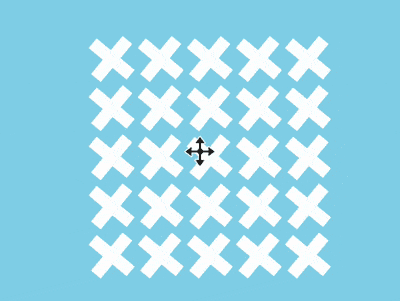Home >Web Front-end >CSS Tutorial >How to use D3 and GSAP to achieve a dancing effect (source code attached)
How to use D3 and GSAP to achieve a dancing effect (source code attached)
- 不言Original
- 2018-09-26 17:22:552599browse
The content of this article is about how to use D3 and GSAP to achieve a dancing effect (source code attached). It has certain reference value. Friends in need can refer to it. I hope it will be useful to you. helped.
Effect preview

Source code download
https://github.com/comehope/front-end-daily -challenges
Code Interpretation
Define dom, the container contains 2 sub-containers, .horizontal represents horizontal line segments, .vertical represents vertical Line segment, each sub-container contains 4 sub-elements:
<div> <div> <span></span> <span></span> <span></span> <span></span> </div> <div> <span></span> <span></span> <span></span> <span></span> </div> </div>
Centered display:
body {
margin: 0;
height: 100vh;
display: flex;
align-items: center;
justify-content: center;
background-color: skyblue;
}
Set the container size, where --side-length is each side of the square matrix Number of elements:
.container {
--side-length: 2;
position: relative;
width: calc(40px * calc(var(--side-length)));
height: calc(40px * calc(var(--side-length)));
}
Use grid layout to arrange sub-elements, 4 elements are arranged into a 2 * 2 square matrix:
.container .horizontal,
.container .vertical {
position: absolute;
top: 0;
left: 0;
display: grid;
grid-template-columns: repeat(var(--side-length), 1fr);
}
Set the style of sub-elements, .horizontal## The child elements within # are horizontal bars, and the child elements within .vertical are vertical bars:
.container .horizontal span {
width: 40px;
height: 10px;
background: #fff;
margin: 15px 0;
}
.container .vertical span {
width: 10px;
height: 40px;
background: #fff;
margin: 0 15px;
} At this point, the static layout is completed, and then d3 is used to batch process the child elements. Introduce d3 library:
<script></script>Delete the sub-element dom node in the html file and delete the css variables declared in the css file.
Define the number of elements on each side of the square matrix, and assign this value to the css variable:
const SIDE_LENGTH = 2;
let container = d3.select('.container')
.style('--side-length', SIDE_LENGTH);Define a function that adds span sub-elements, adding horizontal and vertical ones respectively. Child element:
function appendSpan(selector) {
container.select(selector)
.selectAll('span')
.data(d3.range(SIDE_LENGTH * SIDE_LENGTH))
.enter()
.append('span');
}
appendSpan('.horizontal');
appendSpan('.vertical');At this point, the layout has been changed to dynamic. You can create square matrices with different side lengths by modifying the value of SIDE_LENGTH. For example, the following statement will create a 5 * 5 Square matrix:
const SIDE_LENGTH = 5;Next, use GSAP to create the animation. (Note: Because scrimba will crash when using gsap, the video demonstration uses css animation, but codepen and github both use gsap animation)
Introducing the GSAP library:
<script></script>Declare animation variables
animation, declare variables representing dom elements $horizontalSpan and $verticalSpan:
let animation = new TimelineMax({repeat: -1});
let $horizontalSpan = '.container .horizontal span';
let $verticalSpan = '.container .vertical span'; First create the animation of the horizontal bar, which is divided into 4 steps, each ## The last parameter of the #to statement is the name of the step: <pre class="brush:php;toolbar:false">animation.to($horizontalSpan, 1, {rotation: 45}, 'step1')
.to($horizontalSpan, 1, {x: '-10px', y: '-10px'}, 'step2')
.to($horizontalSpan, 1, {rotation: 0, x: '0', y: '0', scaleY: 2, scaleX: 0.5}, 'step3')
.to($horizontalSpan, 1, {rotation: 90, scaleY: 1, scaleX: 1}, 'step4')</pre>Create the animation of the vertical bar again,
The step name of the statement is the same as the step name of the horizontal bar, so as to match The horizontal bars keep the animation synchronized: <pre class="brush:php;toolbar:false">animation.to($verticalSpan, 1, {rotation: 45}, 'step1')
.to($verticalSpan, 1, {x: '10px', y: '10px'}, 'step2')
.to($verticalSpan, 1, {x: '0', y: '0', scaleX: 2, scaleY: 0.5}, 'step3')
.to($verticalSpan, 1, {rotation: 90, scaleX: 1, scaleY: 1}, 'step4');</pre> Use the time scale scaling function at the end of the animation to double the animation playback speed:
animation.timeScale(2);
Finally, change the side length of the square matrix to 10, square The bigger the formation, the more powerful it will be:
const SIDE_LENGTH = 10;
Done!
The above is the detailed content of How to use D3 and GSAP to achieve a dancing effect (source code attached). For more information, please follow other related articles on the PHP Chinese website!
Related articles
See more- How to use CSS and D3 to achieve the effect of endless hexagonal space
- How to use CSS and D3 to achieve black and white overlapping animation effects
- How to use CSS and D3 to achieve a heart-shaped animation effect composed of text (with code)
- How to use CSS and GSAP to implement continuous animation with multiple keyframes (source code attached)
- How to use CSS and GSAP to implement loader animation of branch sprouting (source code attached)

